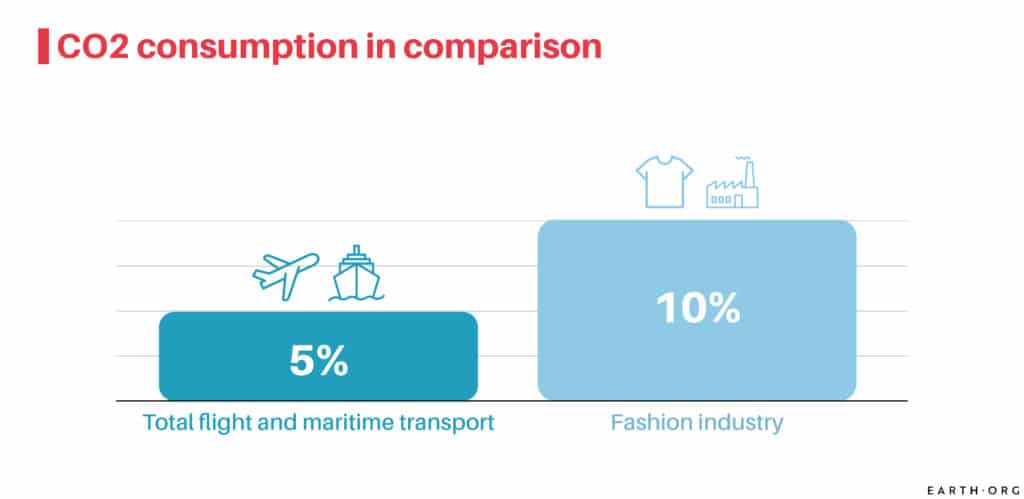Fast fashion has plenty of detrimental effects on the environment. This ever-growing throwaway culture generates an estimated 92 million tonnes of textile waste globally every year and is expected to soar up to 134 million tonnes a year by 2030. The industry also contributes to nearly 10% of global carbon emissions and 20% of global wastewater. Launched in 2018 and renewed in 2021, the United Nations Fashion Industry Charter for Climate Action is an international industry mission statement in which fashion and textile companies commit to achieving net-zero emissions by 2050 and address their roles in climate change.
—
The global fashion, clothing, and textiles industry has soared in the past few decades to become one of the biggest commercial sectors in the world, boasting a worth of up to US$1.5 trillion. But with this meteoric rise comes a steep cost: about 92 million tonnes of textiles waste is produced every year and around 93 billion cubic metres of wastewater is generated from textile dyeing to keep up with current global demands. Most worryingly, the fashion industry now accounts for nearly up to 10% of global carbon emissions, which is more than both the aviation and shipping sectors combined, meaning that fashion is now a major contributor to climate change. The United Nations Framework Convention on Climate Change is therefore addressing this growing issue by launching a dedicated industry charter.

What Is the United Nations Fashion Industry Charter for Climate Action?
The UN Fashion Industry Charter for Climate Action, or simply the UN Fashion Charter, was created with the mission to address the undeniable environmental impacts of the global fashion industry and to drive the sector towards net-zero greenhouse gas emissions by no later than 2050, in line with keeping global warming below 1.5C from pre-industrial levels set out in the Paris Agreement.
First launched at the UN climate summit COP24 in Katowice, Poland, in December 2018, the charter was once again renewed at COP26 in Glasgow, UK, in November 2021.
The UN Fashion charter recognises the detrimental impacts the fashion, clothing and textile industry has on the environment and must take an active role in contributing to achieving the goals in the Paris Agreement. It also acknowledges that current business models and solutions are not sufficient to meet the climate targets in order to avoid a climate catastrophe. The industry as a whole needs to adopt a deeper, more systemic change and scale up low-carbon solutions to realise this vision.
“The fashion industry has a unique opportunity to drive climate action by using its collective strength to transform the industry to low carbon technologies and products through its Fashion Industry Charter for Climate Action,” Niclas Svenningsen, Manager of the UN Global Climate Action writes. “Brands, suppliers, retailers, industry associations and coalitions that signed up to the Charter have the opportunity and responsibility to translate words into decisive action.”
The overarching goals are underpinned by other climate commitments; dedication to Sustainable Development Goals (SDGs), social justice and responsibility, and respect for human rights.
In signing the charter, signatories and supporting organisations of the charter are committed to climate action and decarbonising across the fashion, retail and textile global value chain. Signatories are to work together with fashion stakeholders and experts to deliver the commitments enshrined in the charter via ‘working groups’.
You might also like: How to Recognise Fast Fashion Brands and Which Ones to Avoid
Key Features of the United Nations Fashion Industry Charter
- Hitting net-zero greenhouse gas emissions by 2050, and halving greenhouse gas emissions compared to 2019 levels by 2030.
- Materials such as cotton, viscose, polyester, wool and leather must have a low climate impact by 2030, meaning they must be recycled in a closed loop, and are deforestation-free, land conversion-free, and produced using regenerative practises.
- Phasing out coal from owned and supplier sites as soon as possible and by 2030 latest. There should be no new coal power by January 2023 at the latest.
Key Areas for Working Groups to Develop On
- Developing roadmaps for companies and fashion stakeholders to decarbonise and reduce greenhouse gas emissions
- Securing and adopting 100% of electricity from renewable sources across supply chains
- Promoting and facilitating greater policy engagement.
- Tools and measures to promote broader climate action.
Signatories of the UN Fashion Charter
Since the launch of the charter in 2018 as well as its renewal in 2021, nearly 130 fashion, clothing and textile companies have committed to climate action and to meet the goals embedded in the document. Among the signatories are some of the biggest fashion houses and retailers in the world including Adidas, Chanel, LVMH, and Nike, while fast fashion companies such as H&M and Primark, who are some of the worst culprits of environmental pollution, have notably also made climate action commitments.
43 organisations that are actively engaged in the fashion sector, including Condé Nast – a global media company that owns publications such as Vogue, GQ and Vanity Fair, World Wildlife Fund, and Fashion Revolution – have also signed on the charter, who are in a position to contribute significantly and effectively to the aforementioned goals.

Image: UN Fashion Charter.
Fashion Industry’s Climate Progress So Far
According to the official UN review of the 2020 reporting cycle, in which more than 70% of signatories submitted climate disclosures, nearly 60% of charter members have indicated a reduction in emissions since the last reporting cycle. Another positive finding is that over 85% of responding signatories have embedded the Charter’s climate commitments in their own organisation’s public sustainability strategy.
Based on the disclosure submitted by the companies – public disclosures are also made mandatory from 2021 – the report revealed that an estimated 3.48 metric tonnes of carbon dioxide equivalent were reduced annually, and US$117.14 million were saved as a result of emission reductions. It also found that companies have purchased an average of 33% of total power from renewable sources.
However despite progress, there are still several crucial areas in which signatories are behind, such as the lack of leveraging of internal costs of carbon, and supporting and engaging companies’ own value chain.
You might also like: Fast Fashion and Its Environmental Impact


















